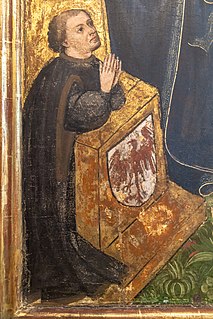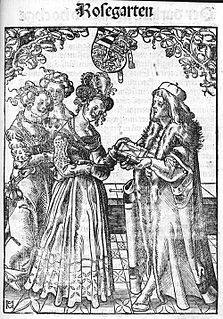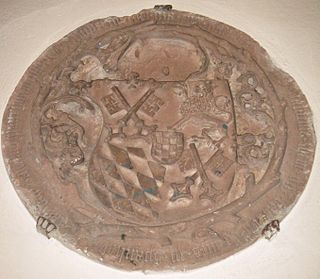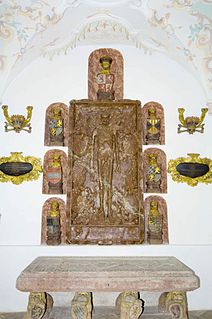
The House of Wittelsbach is the Royal Bavarian dynasty from Germany, with branches that have ruled over territories including Bavaria, the Palatinate, Holland and Zeeland, Sweden, Hungary, Bohemia, the Electorate of Cologne and other prince-bishoprics, and Greece. Their ancestral lands of the Palatinate and Bavaria were Prince-electorates, as well as the Archbishopric-Electorate of Cologne, and the family had three of its members elected emperors and kings of the Holy Roman Empire. Their Kingdom of Bavaria was created in 1805 and continued to exist until 1918.

Frederick was the last Burgrave of Nuremberg from 1397 to 1427, Margrave of Brandenburg-Ansbach from 1398, Margrave of Brandenburg-Kulmbach from 1420, and Elector of Brandenburg from 1415 until his death. He became the first member of the House of Hohenzollern to rule the Margraviate of Brandenburg.
The history of Bavaria stretches from its earliest settlement and its formation as a stem duchy in the 6th century through its inclusion in the Holy Roman Empire to its status as an independent kingdom and finally as a large Bundesland (state) of the Federal Republic of Germany. Originally settled by Celtic peoples such as the Boii, by the 1st century BC it was eventually conquered and incorporated into the Roman Empire as the provinces of Raetia and Noricum.

The Duchy of Bavaria was a frontier region in the southeastern part of the Merovingian kingdom from the sixth through the eighth century. It was settled by Bavarian tribes and ruled by dukes (duces) under Frankish overlordship. A new duchy was created from this area during the decline of the Carolingian Empire in the late ninth century. It became one of the stem duchies of the East Frankish realm which evolved as the Kingdom of Germany and the Holy Roman Empire.

Duke Albert IV of Bavaria-Munich, was Duke of Bavaria-Munich from 1467, and Duke of the reunited Bavaria from 1503.

Rudolf I of Bavaria, called "the Stammerer", a member of the Wittelsbach dynasty, was Duke of Upper Bavaria and Count Palatine of the Rhine from 1294 until 1317.
Louis I, called the Kelheimer or of Kelheim, since he was born and died at Kelheim, was the Duke of Bavaria from 1183 and Count Palatine of the Rhine from 1214. He was a son of Otto I and his wife Agnes of Loon. Louis was married to Ludmilla, a daughter of Duke Frederick of Bohemia.

St. Emmeram's Abbey, now known as Schloss Thurn und Taxis, Schloss St. Emmeram, and St. Emmeram's Basilica, was a Benedictine monastery founded in about 739 in Regensburg in Bavaria at the grave of the itinerant Frankish bishop Saint Emmeram.

Philip the Upright was an Elector Palatine of the Rhine from the house of Wittelsbach from 1476 to 1508.

Catherine of Pomerania-Wolgast was the wife of Henry IV, Duke of Brunswick-Lüneburg, Prince of Wolfenbüttel. She was the daughter of Eric II, Duke of Pomerania-Wolgast, and Sophia of Pomerania-Stolp.
Sponheim or Spanheim was a medieval German noble family, which originated in Rhenish Franconia. They were immediate Counts of Sponheim until 1437 and Dukes of Carinthia from 1122 until 1269. A cadet branch ruled in the Imperial County of Ortenburg-Neuortenburg until 1806.

The Margraviate of the Nordgau or Bavarian Nordgau was a medieval administrative unit (Gau) on the frontier of the German Duchy of Bavaria. It comprised the region north of the Danube and Regensburg (Ratisbon), roughly covered by the modern Upper Palatinate stretching up to the river Main and, especially after 1061, into the Egerland on the border with Bohemia.

Absberg was a local noble family in Franconia.
Barbara von Absberg was abbess of Obermünster in Regensburg from 1435 to 1456.
Albert of Palatinate-Mosbach or Albert of Bavaria was a Roman Catholic clergyman who was bishop of Strasbourg from 1478 to 1506.
Rupert of Palatinate-Mosbach was a German nobleman and clergyman. From 1457 to his death he was the forty-third bishop of Regensburg, as Rupert I.

Rupert of Palatinate-Simmern was a German nobleman and clergyman of the house of Palatinate-Simmern. From 1492 until his death he was the forty-fifth bishop of Regensburg as Rupert II.

John of Palatinate-Mosbach was a prince of the house of Wittelsbach and Dompropst or canon of Augsburg Cathedral and Regensburg Cathedral.












